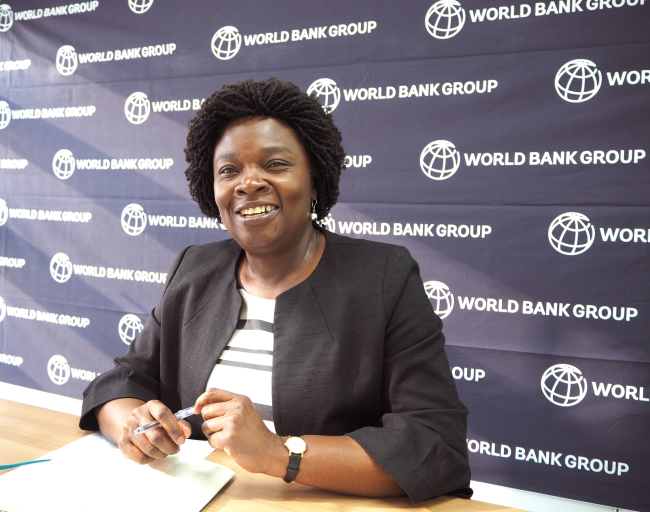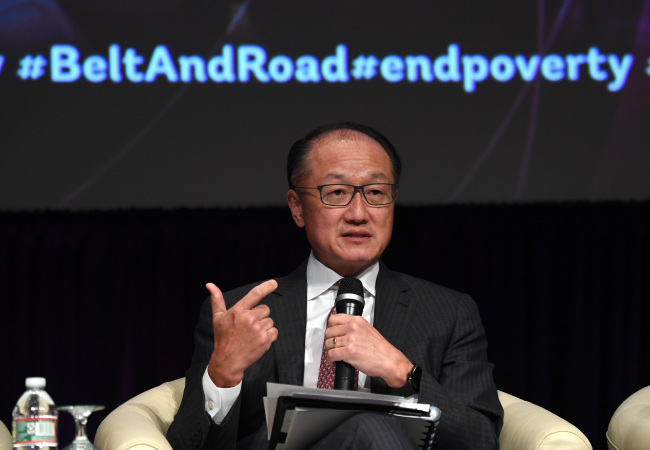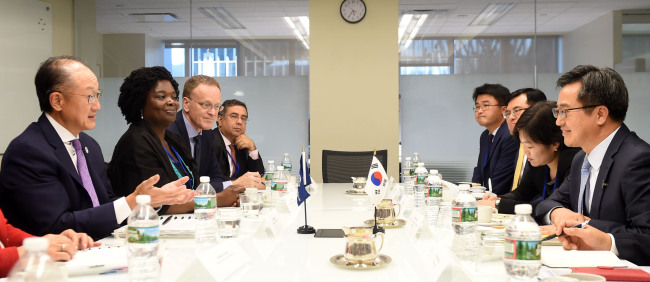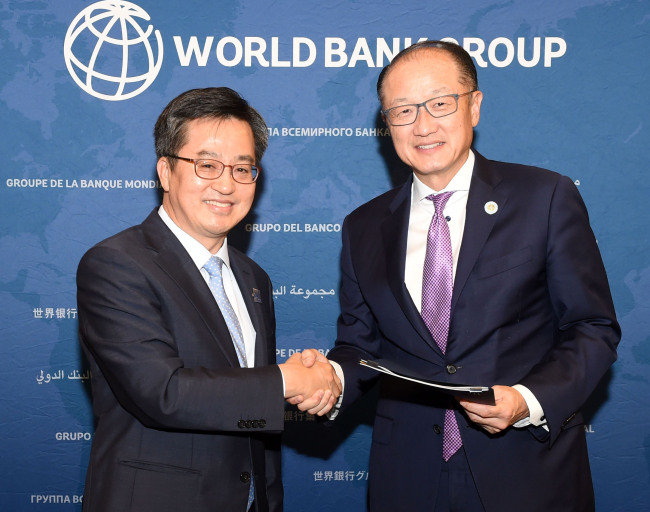The World Bank and Korea are working side by side to tackle some of the world’s most paramount economic challenges, said the multilateral institution’s senior executive, noting the partners increasingly draw on each other’s financial acumen and developmental expertise in the service of global sustainable development.
Victoria Kwakwa, World Bank regional vice president of East Asia and the Pacific, stressed in an exclusive interview that Korea’s knowledge and experience in postwar economic growth -- buoyed by the bank’s financial and technical assistance -- have crucially helped developing Asian economies forge a sustainable strategy forward.
“It’s not just about giving money in the form of aid, but transferring successful development experience and knowledge. It’s about providing practical help and technical assistance working in consort with institutions like the Korea Development Institute,” she told The Korea Herald at the World Bank Group satellite office in Seoul.
Areas of collaboration include guidance on the financial sector, economic policy, public investment planning, green growth, sustainable development, urban planning, poverty reduction and higher education, among others, she added, noting the two sides utilize trust funds set up by the Korean government.
 |
Victoria Kwakwa, World Bank regional vice president of East Asia and the Pacific (Joel Lee/The Korea Herald) |
A successful example is a co-financing arrangement through the Korea Eximbank’s Economic Development Cooperation Fund to develop the Tina River Hydropower Project in the Solomon Islands.
Korea’s hydropower company K-Water has been selected for the project with resources from the Korean government, World Bank and other partners in a consortium. “The project will bring huge changes to how electricity will be delivered in the country,” Kwakwa said.
Through the Korean Green Growth Trust Fund, the World Bank and Korea are helping the energy transition of fossil fuel-dependent economies, including China, Indonesia, Vietnam and Philippines, toward renewables. “We bring in technological and concessional expertise so that the renewables’ costs are competitive over fossil fuel,” according to the economist.
Responding to global warming and rising sea levels, the two have collaborated in formulating climate adaption measures, as well as nationally determined contributions for governments, as they strive to lower their carbon emissions in adherence to the United Nations-led Paris agreement.
“Several countries are coming up with their own green growth strategies, and this is where the World Bank and Korea can work together,” she said.
 |
World Bank President Jim Yong Kim speaks during a high-level seminar on the Belt and Road Initiative in Washington D.C., the United States, Oct. 12, 2017. China's Ministry of Finance and the World Bank on Thursday held a high-level seminar on the Belt and Road Initiative for the first time during the bank's annual meetings. (Yonhap) |
Kwakwa pointed to other cases where the bank and Korean government -- partners since 1955 -- have organized workshops and seminars to explore the nature of conflicts and offer technical assistance to conflict-ridden countries. One example is Myanmar, which began a transition to democracy in 2010 following decades of military dictatorship, and where the Rohingya Muslim minority has recently faced persecution and fled to neighboring Bangladesh.
The World Bank Group is a family of five organizations: the International Bank for Reconstruction and Development, the International Development Association, International Finance Corp., the Multilateral Investment Guarantee Agency and the International Center for Settlement of Investment Disputes.
Korea joined the IBRD in 1955, the IDA in 1961 and the IFC in 1964. It exited these programs by 1995, only to rejoin following the 1997 Asian financial crisis. Korea graduated from the IBRD in 2016.
Kwaka lauded Seoul’s continuous and increasing contributions to international aid through its official development assistance program. After joining the IDA in 1961, Korea made its first contribution in 1977 as a donor country, and in 2009 entered the Organization for Economic Cooperation and Development’s Development Assistance Committee.
Korea currently spends 0.14 percent of its gross national income on development assistance, and plans to increase that to 0.2 percent by 2020 and 0.3 percent by 2030. In 2015, Korea provided $1.9 billion in net ODA.
 |
World Bank President Jim Yong Kim (left) and World Bank Regional Vice President for East Asia and Pacific Victoria Kwakwa (second from left) speak to Korean Finance Minister Kim Dong-yeon (right) and other policymakers in Washington on Oct. 15 (Yonhap) |
“Korea’s focus on the quality of its aid program, by combining the financial contribution with knowledge and hands-on expertise, is laudable,” the vice president said. “Money doesn’t automatically bring results you expect if you don’t use it properly.”
The economist expressed a strong affirmation of partnership with the Asian Infrastructure Investment Bank, a multilateral development bank headquartered in Beijing that aims to support infrastructure development across the Asia-Pacific region.
“The World Bank and AIIB work closely by co-financing projects across Asia and North Africa,” she said, noting they use uniform rules and standards regarding lending, social and environmental impact and others that lower transaction costs for clients.
The two are heavily involved in the China-led “One Belt One Road” initiative to develop infrastructure and trade links across Eurasia, Southeast Asia, South Asia, Oceania and Northeast Africa via the land-based Silk Road Economic Belt and the oceangoing Maritime Silk Road.
 |
World Bank President Jim Yong Kim (right) and Korean Finance Minister Kim Dong-yeon pose after signing a memorandum of understanding to expand the capacity of the World Bank Group Korea Office in Songdo, Incheon on Oct. 14. (Yonhap) |
China signed a memorandum of understanding with multilateral financial organizations including the World Bank, AIIB, Asian Development Bank and European Investment Bank for the gargantuan worldwide integration project. Korea joined the AIIB in June 2015.
“What we can bring to the OBOR is strong analytic work around the initiative,” she said, adding sound analysis and policy advice underpin projects’ implementation. “It’s important to understand the economics of the six corridors that are part of the OBOR, explore existing opportunities as well as assess risks and challenges, such as the debt sustainability of participating countries.”
Kwakwa underscored that in the absence of sound policies on trade, integration and connectivity, the roads, highways, airports and railways that will be built cannot realize their maximum impact.
“We help in project selection so that they are aligned with strategic priorities of governments involved as well as our individual partnerships with countries,” she said. “We help structure those projects to bring in private commercial money, and also co-finance them with our own money.”
By Joel Lee (
joel@heraldcorp.com)











